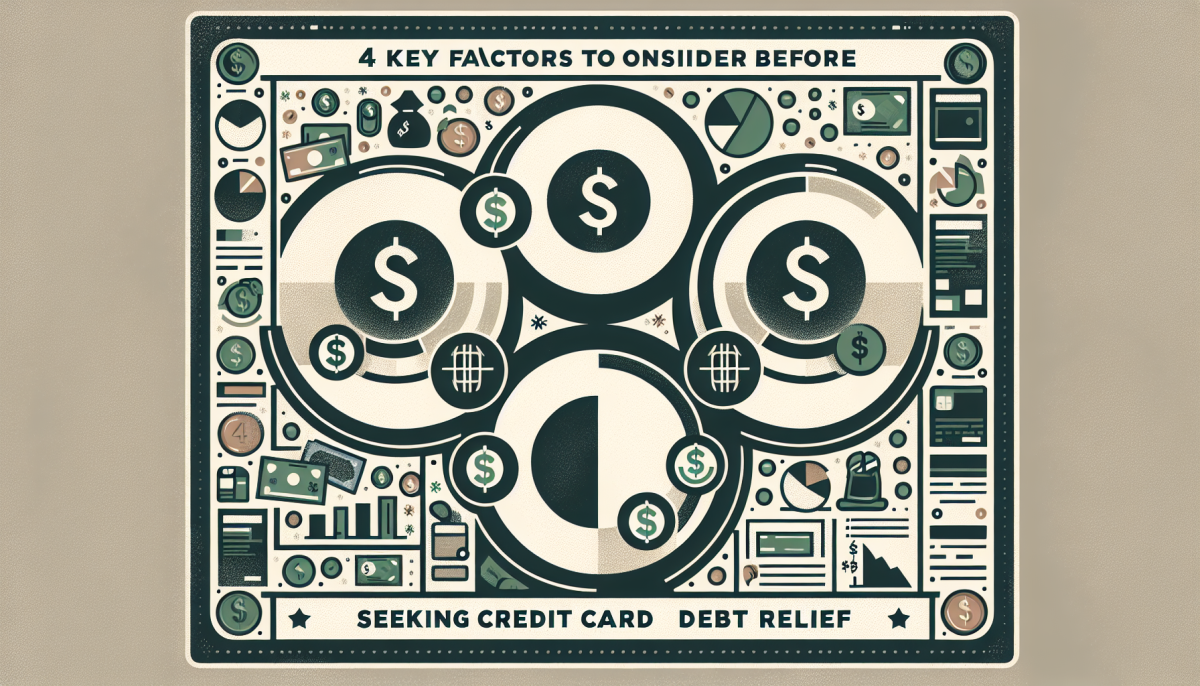Credit card debt can be a heavy burden, often leading to stress and financial strain. Finding a viable solution is crucial for regaining financial stability and peace of mind. However, before jumping into credit card debt relief options, it’s essential to understand the basics and carefully evaluate your unique financial situation. In this article, we will discuss four key factors to consider before seeking credit card debt relief, under two primary headings: “Understanding the Basics of Credit Card Debt Relief” and “Evaluating Your Financial Situation and Options.”
Understanding the Basics of Credit Card Debt Relief
Credit card debt relief encompasses various strategies designed to help consumers lower or manage their debt more effectively. These strategies can range from debt consolidation and credit counseling to debt settlement and bankruptcy. Each approach offers different benefits and potential drawbacks, making it essential to know what each entails. For example, debt consolidation involves combining multiple debts into a single, more manageable payment, often with a lower interest rate. On the other hand, debt settlement aims to reduce the total debt amount, which can negatively impact your credit score.
Another fundamental aspect of credit card debt relief is understanding the eligibility criteria and conditions associated with each option. For instance, some debt relief programs are only available to individuals who meet specific financial hardship criteria, such as job loss or medical emergencies. Ensuring that you qualify for a particular program before applying can save time and help you avoid potential pitfalls. Additionally, it’s important to research the reputation and credibility of debt relief companies, as scams and unethical practices are unfortunately common in this field.
Lastly, the financial implications of choosing a debt relief option cannot be overstated. While some programs may offer immediate relief, they might also come with long-term consequences, such as damage to your credit score or additional fees. It’s essential to weigh the short-term benefits against the long-term impact on your financial health. Consulting with a financial advisor or credit counselor can provide valuable insights and help you make an informed decision that aligns with your financial goals and circumstances.
Evaluating Your Financial Situation and Options
Before opting for any credit card debt relief solution, a thorough evaluation of your financial situation is imperative. Start by reviewing your income, expenses, and existing debt obligations. Creating a detailed budget can help you visualize your cash flow and identify areas where you can cut costs or allocate more resources towards debt repayment. Understanding your financial picture is the first step in determining which debt relief option might be the most effective for your situation.
Next, consider the different debt relief options available and how they align with your financial goals. For instance, if you are primarily looking to lower your monthly payments, debt consolidation might be a suitable choice. However, if reducing the total amount of debt is your priority, debt settlement could be more appropriate. It’s also important to consider the potential impact on your credit score. Debt management plans, for example, generally have a lesser negative effect on your credit compared to debt settlement or bankruptcy.
Moreover, evaluate the legal and tax implications of the debt relief options you are considering. For instance, forgiven debt through settlement can be considered taxable income by the IRS, potentially leading to a significant tax bill. Bankruptcy, while offering a fresh financial start, comes with its own set of legal complexities and long-term consequences. It’s crucial to understand these implications fully and seek professional advice if necessary to ensure you are making the best possible decision for your financial future.
Seeking credit card debt relief is a significant step towards regaining control of your financial health. By understanding the basics of various debt relief options and thoroughly evaluating your financial situation, you can make an informed choice that aligns with your long-term financial goals. Remember, it’s essential to consider both the immediate benefits and potential long-term consequences of any debt relief strategy. Consulting with financial experts and doing comprehensive research will equip you with the knowledge needed to navigate this challenging process successfully.


